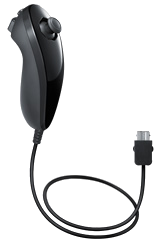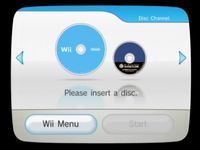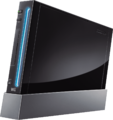Wii
 ウィー Wii | ||||||||||||||||
 The original White Wii | ||||||||||||||||
Release dates
| ||||||||||||||||
Technical specs
| ||||||||||||||||
Related information
| ||||||||||||||||
External links
|
Wii (Japanese: ウィー Wii) is Nintendo's seventh-generation console, which serves as the company's competition for Sony's PlayStation 3 and Microsoft's Xbox 360. Its handheld counterpart is the Nintendo DS. The Nintendo 3DS's graphical and CPU capabilities are nearly identical to the Wii. Like its predecessor, the Nintendo GameCube, the Wii is able to connect to software titles on the handheld of this generation, the Nintendo DS; has a Pokémon game that serves as a battle arena for the Generation IV Pokémon games—in this case, Pokémon Battle Revolution; and also has a storage system: My Pokémon Ranch. It was succeeded by the Wii U, which is backwards-compatible with all Wii games and controllers.
It was discontinued in Japan and Europe on October 20, 2013.[4][5][6]
Features
Wii Remote
The Wii's controller design is unconventional; instead of taking the dual-control-stick layout of the previous generation like its competitors, it is in a remote control form, with attachments available to work with compatible games, such as a control stick on a Nunchuk attachment, or the Classic Controller, which takes on a layout similar to other consoles' main controllers. The Wii Remote is wireless, and features such innovations as motion and tilt sensing, a first for game controllers. Its sensitivity can be enhanced with Wii Motion-Plus, although currently it is not compatible with any Pokémon games.
Wii Menu
The console features a custom GUI made up of different - and expandable - channels, all of which, save the Disc Channel, can be moved around to any of the 47 spaces available on the main menu. New channels can be downloaded via the Wii Shop Channel, and include an Internet browser and games from older systems playable via Virtual Console. The channels can be put on an SD card, and with the introduction of Wii Menu 3.3, SD Card menus can be accessed straight from the main menu.
The Wii also has the ability to send messages to and from other devices, so long as the Wii sends out an initial address book confirmation message to the email address or cell phone number in question. When the recipient replies to the Wii's message, communication between the two devices will be active, and via WiiConnect24, others can leave messages for players of the console on its message board from anywhere in the world. However, this feature, along with a few channels, was discontinued on June 30, 2013.
Backward compatibility
The Wii is backwards-compatible with all GameCube games, as well as with most of GameCube's accessories, such as the controllers, memory cards, GameCube-to-GBA cables, and microphone. It is not compatible with the Rumble Pak or the Game Boy Player.
Technical specs
- Compatibility with both 12cm Wii Game Discs and 8cm GameCube Game Discs
- 729 MHz "Broadway" IBM CPU
- 243 MHz "Hollywood" ATI GPU
- 88 MB total memory, 24 MB Mo-Sys 1T-SRAM, 324 MHz, 2,7 GB/s bandwidth
- 512 MB internal flash memory, for game, channel, and data saving
- SD memory card bay for expansion of save space. Initially, the system supported SD cards up to 2 GB. After the Wii System 4.0 update, the system supports SDHC cards up to 32 GB (However, games released before the system update may not read SDHC cards), GameCube memory cards (First model only).
- Two USB ports for expansion and/or networking capabilities
Pokémon games
On game discs
Most Wii games are released on the Wii's own 12cm discs. So far, there are four known games that feature Pokémon.
| Title | Genre | Release |
|---|---|---|
| Pokémon Battle Revolution | Battle simulation | 2006 |
| Super Smash Bros. Brawl | Versus fighting | 2008 |
| PokéPark Wii: Pikachu's Adventure | Action-adventure | 2009 |
| PokéPark 2: Wonders Beyond | Action-adventure | 2012 |
GameCube games
Because the Wii features backwards compatibility with the majority of Nintendo GameCube hardware, all Pokémon games for the GameCube are also playable on the Wii; however, the Wii is not compatible with the Game Boy Player.
| Title | Genre | Release |
|---|---|---|
| Super Smash Bros. Melee | Versus fighting | 2001 |
| Pokémon Box Ruby & Sapphire | Utility | 2003 |
| Pokémon Channel | Virtual pet | 2003 |
| Pokémon Colosseum | RPG | 2003 |
| Pokémon XD: Gale of Darkness | RPG | 2005 |
With Pokémon Box Ruby & Sapphire emulator
| Title | Genre | Release |
|---|---|---|
| Pokémon Ruby and Sapphire | Main series RPG | 2003 |
WiiWare games
WiiWare games are special games downloadable via the Wii Shop Channel. Two Pokémon games have been released worldwide, and a third has been released only in Japan.
| Title | Genre | Release | Cost |
|---|---|---|---|
| My Pokémon Ranch | Virtual life | 2008 | 1000 Wii Points |
| Pokémon Rumble | Action RPG | 2009 | 1500 Wii Points |
| Pokémon Mystery Dungeon (WiiWare) | Dungeon crawler | 2009 | 1200 Wii Points |
Virtual Console games
Virtual Console games are old games that were originally released on past consoles, and have now been re-released on the Wii Shop Channel. Like WiiWare games, they can be downloaded after being bought. There are two Pokémon games that have received this treatment so far, plus the original Super Smash Bros. game.
| Title | Genre | Original system | Original release | VC release |
|---|---|---|---|---|
| Pokémon Snap | First-person rail shooter | Nintendo 64 | 1997 | 2007 |
| Pokémon Puzzle League | Puzzle | Nintendo 64 | 2000 | 2008 |
| Super Smash Bros. | Versus fighting | Nintendo 64 | 1999 | 2009 |
Channels
Wii Shop Channel
The Wii Shop Channel is a channel which comes pre-installed on Wii consoles. It uses the Internet to purchase and download WiiWare, Virtual Console games and channels with Wii Points.
Nintendo Channel
The Nintendo Channel is a free downloadable channel which contains various videos and demos of Nintendo games. Use of this channel requires the Internet. These videos are often commercials, trailers, and interviews relating to Nintendo products. All Pokémon games for Nintendo DS and Wii (excluding Virtual Console) that have had an English language release have been featured on the channel at some point.
Additionally, the channel has a feature called the DS Download Service, which allows players to download demos of games to a Nintendo DS system via DS Download Play. Demos for Pokémon Ranger: Guardian Signs, Pokémon Trozei! and Pokémon Mystery Dungeon: Explorers of Sky can be downloaded. Explorers of Sky has three slightly different demos.
The channel was discontinued on June 30, 2013.
Gallery
Variants
Wii Family Edition
The Wii Family Edition is a special model of Wii that removes features from the Wii so it can be sold at a lower price. It is not compatible with Nintendo GameCube games or hardware like the original model was. It is designed to sit horizontally rather than upright like the original model. It was released on October 23, 2011 in North America and November 4, 2011 in Europe.
Wii mini
The Wii mini is a special model of Wii that removes features from the Wii so it can be sold at a lower price. It is not compatible with Nintendo GameCube games or hardware, has no online functions, and does not have an SD card slot, restricting the console to only playing games from Wii game discs. It also only has one USB port rather than the two on the original Wii, and can only use composite video cables rather than the S-Video and component video cables used by the original Wii. It was released in Canada on December 7, 2012 and Europe on March 22, 2013, and became available in the United States on November 17, 2013.
Cameos
- Players have a Wii in their bedroom in Generation IV and Generation V. In Pokémon Diamond, Pearl, and Platinum, Barry has a Wii in his room, as well. In Pokémon HeartGold and SoulSilver, the player's alternate-gender counterpart, Red, and Blue each have a Wii. There is also a Wii next to a TV on the S.S. Aqua.
- In Pokémon Diamond, Pearl, and Platinum, in the Underground, there is a Wii decoration, titled "game system", for the player's Secret Base.
- The player character's bedroom in Pokémon Ranger: Shadows of Almia has a Wii next to the TV set in Chicole Village.
- The remote control for the evolution machine featured in Ya See We Want an Evolution was similar in design to the controller of the Wii.
- The remote Meowth used in The Grass-type is Always Greener! resembled the Nunchuk.
- A Wii console, along with a Wii Balance Board, Wii Zapper, and a Wii Remote Hand Grip Pad make an appearance in Diamond's room in the Pokémon Adventures manga in Stopping Sableye.
Wii Remote as seen in Ya See We Want an Evolution
Nunchuk as seen in The Grass-type is Always Greener!
The Wii as seen in Stopping Sableye
Trivia
- The Nunchuk resembles part of a Nintendo 64 controller.
- The Wii can play the first three Super Smash Bros. titles.
External links
- Nintendo (Japanese)
References
- ↑ Nintendo Life: South Korea gets their own Virtual Console
- ↑ Nintendo Hong Kong site
- ↑ Nintendo Phuten site
- ↑ Engadget - Nintendo stops selling Wii consoles in Japan
- ↑ GameSpot - Wii discontinuation in Japan won't affect availability in United States
- ↑ Time also called on Wii in Europe | Games industry news | MCV
| Game systems with Pokémon games |
|---|
| Nintendo handheld consoles |
| GB (Pocket · GBL · SGB · SGB2) • GBC • mini • GBA (SP · GBm · GBP) DS (Lite · DSi · DSi XL) • 3DS (XL · 2DS · New 3DS · New 3DS XL · New 2DS XL) Switch (Lite · OLED) |
| Nintendo home consoles |
| SNES (BS-X · SGB · NP · SGB2) • N64 (DD) • GCN (GBP) Wii (Family Edition · mini) • Wii U Switch (OLED) |
| Sega consoles |
| Pico • CoCoPad • Beena |










